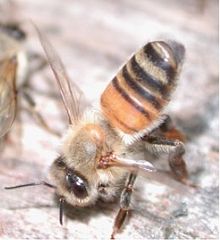Pheromone: Difference between revisions
Violetriga (talk | contribs) |
vote for this article to be improved by WP:AID |
||
| Line 1: | Line 1: | ||
<div style="text-align: center; margin: 0 10%;"> |
|||
{| id="{{{id}}}" style="background: #FFE4E1; border: 2px solid #DB7093; margin: 0 auto;" |
|||
|- |
|||
| [[Image:Aidlogo.png|40px| ]] |
|||
| '''This article has been nominated for [[Wikipedia:This week's improvement drive|the improvement drive]]!''' <br> <small>Please see [[Wikipedia:This week's improvement drive#Nominations|this page's entry]] to vote or comment.</small> |
|||
|} |
|||
</div> |
|||
[[Image:Nasinov_9024.JPG|right|thumb|Fanning [[honeybee]] exposes [[Nasonov]] gland (white-at tip of abdomen) releasing pheromone to entice swarm into an empty hive]] |
[[Image:Nasinov_9024.JPG|right|thumb|Fanning [[honeybee]] exposes [[Nasonov]] gland (white-at tip of abdomen) releasing pheromone to entice swarm into an empty hive]] |
||
A '''pheromone''' is any chemical or mixture of chemicals produced by a living organism that transmits a message to other members of the same species. There are alarm pheromones, food trail pheromones, sex pheromones, and many others. Their use among [[insect]]s has been particularly well documented, although many [[vertebrate]]s also communicate using pheromones. The existence of [[human]] pheromones is debated. |
A '''pheromone''' is any chemical or mixture of chemicals produced by a living organism that transmits a message to other members of the same species. There are alarm pheromones, food trail pheromones, sex pheromones, and many others. Their use among [[insect]]s has been particularly well documented, although many [[vertebrate]]s also communicate using pheromones. The existence of [[human]] pheromones is debated. |
||
Revision as of 11:12, 18 January 2006
| This article has been nominated for the improvement drive! Please see this page's entry to vote or comment. |

A pheromone is any chemical or mixture of chemicals produced by a living organism that transmits a message to other members of the same species. There are alarm pheromones, food trail pheromones, sex pheromones, and many others. Their use among insects has been particularly well documented, although many vertebrates also communicate using pheromones. The existence of human pheromones is debated.
Insect pheromones of pest species, such as the Japanese beetle and the gypsy moth, can be used to trap them or to create confusion so that the pests do not mate, and therefore do not lay eggs. Bombykol is a pheromone released by the female silkworm to attract mates.
In mammals and reptiles, pheromones may be detected by the vomeronasal organ, or Jacobson's organ, which lies between the nose and mouth, although some are detected by regular olfactory membranes.
Human pheromones
Some commercially-available substances are advertised using claims that the products contain sex pheromones and can act as an aphrodisiac. These claims often lack credence due to an excessive marketing of pheromones by unsolicited e-mail, and their effectiveness has not been demonstrated scientifically.
Nevertheless, a few well-controlled scientific studies have been published demonstrating the possibility of pheromones in humans. The best-studied case involves the synchronization of menstrual cycles among women based on unconscious odor cues (by Martha McClintock, Professor of Psychology at the University of Chicago). This study states that there are two types of pheromone involved: "One, produced prior to ovulation, shortens the ovarian cycle, and the second, produced just at ovulation, lengthens the cycle". Other studies have suggested that people might be using odor cues associated with the immune system to select mates who are not closely related to themselves. (see Disassortative sexual selection)
Pheromones in humans are believed to be produced by the apocrine glands. These glands become functional after reaching puberty, which could explain why most people develop an attraction for others at that time. Pheromones could also be the reason why a person can sense "chemistry", or feel an instant attraction or dislike when first meeting someone.
"Using a brain imaging technique, Swedish researchers have shown that homosexual and heterosexual men respond differently to two odors that may be involved in sexual arousal, and that the gay men respond in the same way as women. The new research may open the way to studying human pheromones, as well as the biological basis of sexual preference. Pheromones, chemicals emitted by one individual to evoke some behavior in another of the same species, are known to govern sexual activity in animals, but experts differ as to what role, if any, they play in making humans sexually attractive to one another." New York Times
Pheromones in fiction
Pheromones are a popular device in fiction, including the novel Jitterbug Perfume by Tom Robbins and the film Love Potion No. 9. They were also mentioned in an episode of Wolfgang Petersen's television series The Agency. In the Star Trek universe, female Orions are said to have powerful pheromones which men find hard to resist.
Resources
- Karlson, P., Lüscher, M. 1959. Pheromones: a new term for a class of biologically active substances. Nature 183: 55-56.
- Wilson, E. O., Bossert, W. H. 1963: Chemical communication among animals. Recent Progress in Hormone Research 19: 673-716.
See also
- Quorum sensing
- Bees (Honey Bee Pheromones)
- Pheromone (honey bee)
- Androstenone
- Semiochemical
- Allomone
- Kairomone
